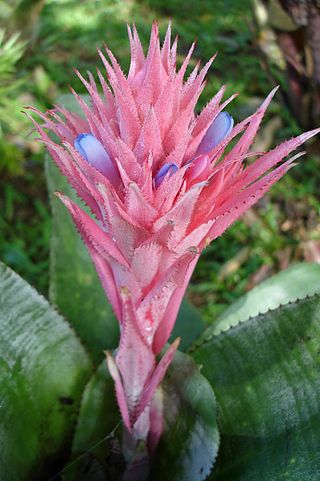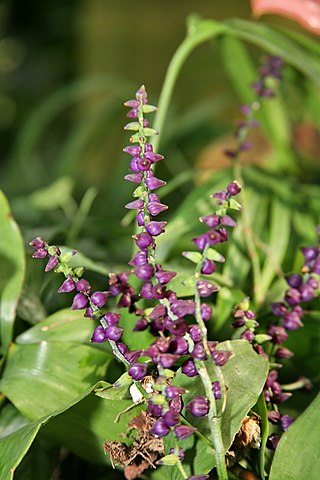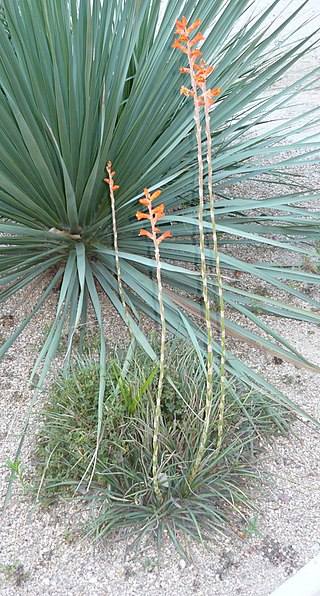
The Bromeliaceae are a family of monocot flowering plants of about 80 genera and 3700 known species, native mainly to the tropical Americas, with several species found in the American subtropics and one in tropical west Africa, Pitcairnia feliciana.

Aechmea is a genus of flowering plants in the family Bromeliaceae. The name comes from the Greek aichme, meaning "spear". Suggested pronunciations include EEK-me-ə and eek-MEE-ə. Aechmea comprises eight subgenera and around 250 species distributed from Mexico through South America and the Caribbean. Most of the species in this genus are epiphytes.

Cryptanthus is a genus of flowering plants in the family Bromeliaceae, subfamily Bromelioideae. The genus name is from the Greek cryptos (hidden) and anthos (flower). The genus formerly had two recognized subgenera: the type subgenus and subgenus HoplocryptanthusMez which has been raised to the separate genus Hoplocryptanthus. All species of this genus are endemic to Brazil. The common name for any Cryptanthus is "Earth star".

Orthophytum is a genus in the plant family Bromeliaceae, subfamily Bromelioideae.

Lymania is a genus in the plant family Bromeliaceae, subfamily Bromelioideae. The genus was established in 1984 to "unite furrowed or winged species from Aechmea subgenera Lamprococcus, Araeococcus and Ronnbergia."

Amaro Macedo was a Brazilian botanist who was the best-known collector of the Brazilian Cerrado plant species of the 20th century. He lived in Ituiutaba, in the state of Minas Gerais, Brazil. He started his collection in 1943 when he was a teacher of natural sciences in the Instituto Marden, Ituiutaba. He collected most of his plant material in the Cerrado vegetation of the states of Minas Gerais, Goiás, Maranhão and Pará. He collected also in the regions of the villages of Natividade, Porto Nacional and Filadelfia, at the time part of the state of Goiás, although now part of the state of Tocantins. Plant specimens from his collection are in several herbaria in Brazil and outside. Between 1943 and 2007 he collected 6,008 plant specimens, several of them are considered new species and some were named for him by fellow botanists.

Quesnelia edmundoi is a species of flowering plant in the family Bromeliaceae, endemic to Brazil. It was first described by Lyman Bradford Smith in 1851. It is found in the Atlantic Forest ecoregion only within Rio de Janeiro state, in southeastern Brazil.
Wittmackia bicolor is a species of flowering plant in the family Bromeliaceae, endemic to south Brazil. It was first described by Lyman Bradford Smith in 1955 as Aechmea bicolor.

Karawata gustavoi is a species of flowering plant in the family Bromeliaceae, endemic to northeastern Brazil. It was first described in 2001 as Aechmea gustavoi.

Karawata multiflora is a species of flowering plant in the family Bromeliaceae, endemic to northeastern Brazil. It was first described by Lyman Bradford Smith in 1937 as Aechmea multiflora.

Karawata saxicola is a species of flowering plant in the family Bromeliaceae, native to southeastern Brazil, in the states of Espírito Santo and Rio de Janeiro. It was first described by Lyman Bradford Smith in 1950 as Aechmea saxicola.
Rokautskyia pseudoscaposa is a species of flowering plant in the family Bromeliaceae, endemic to Brazil. It was first described by Lyman Bradford Smith in 1955 as Cryptanthus pseudoscaposus.
Quesnelia imbricata is a species of flowering plant in the family Bromeliaceae, endemic to Brazil. It was first described by Lyman Bradford Smith in 1952. It is found in the Atlantic Forest ecoregion of southeastern Brazil.

Quesnelia seideliana is a species of flowering plant in the family Bromeliaceae, endemic to Brazil. It was first described in 1963. It is found in the Atlantic Forest ecoregion within Rio de Janeiro state, in southeastern Brazil.

Tillandsia tenuifolia, the narrowleaf airplant, is a species in the genus Tillandsia. This species is widespread across much of South America and the Caribbean islands.

Dyckia remotiflora is a plant species in the genus Dyckia. It is native to Argentina, Uruguay, and Brazil.

Karawata is a genus of flowering plant in the family Bromeliaceae, native to eastern Brazil. The genus was first described in 2019.
Karawata hostilis is a species of flowering plant in the family Bromeliaceae, endemic to Brazil. It was first described in 1972 as Aechmea hostilis.
Karawata nigribracteata is a species of flowering plant in the family Bromeliaceae, native to Brazil. It was first described in 2014 as Aechmea nigribracteata.

Karawata prasinata is a species of flowering plant in the family Bromeliaceae, native to Brazil. It was first described in 2015 as Aechmea prasinata.














